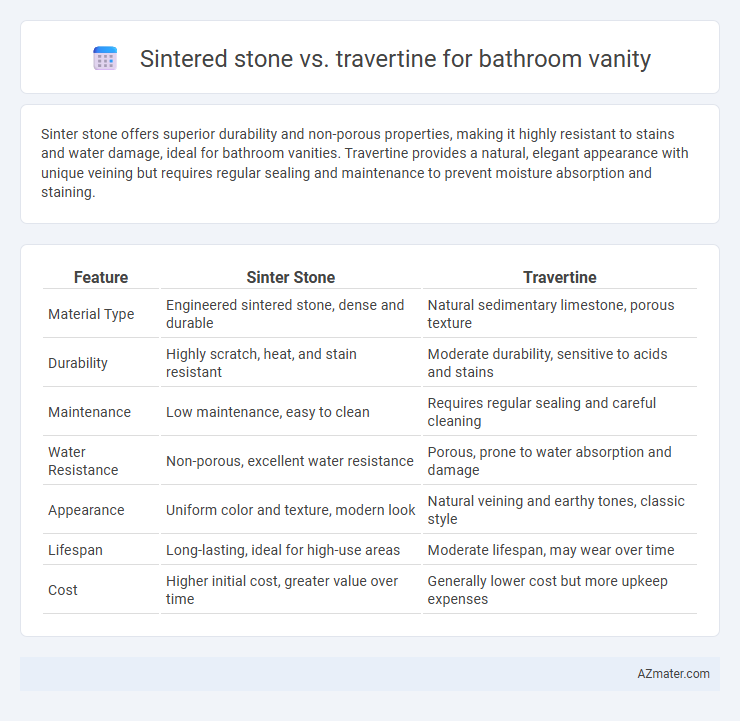Sinter stone offers superior durability and non-porous properties, making it highly resistant to stains and water damage, ideal for bathroom vanities. Travertine provides a natural, elegant appearance with unique veining but requires regular sealing and maintenance to prevent moisture absorption and staining.
Table of Comparison
| Feature | Sinter Stone | Travertine |
|---|---|---|
| Material Type | Engineered sintered stone, dense and durable | Natural sedimentary limestone, porous texture |
| Durability | Highly scratch, heat, and stain resistant | Moderate durability, sensitive to acids and stains |
| Maintenance | Low maintenance, easy to clean | Requires regular sealing and careful cleaning |
| Water Resistance | Non-porous, excellent water resistance | Porous, prone to water absorption and damage |
| Appearance | Uniform color and texture, modern look | Natural veining and earthy tones, classic style |
| Lifespan | Long-lasting, ideal for high-use areas | Moderate lifespan, may wear over time |
| Cost | Higher initial cost, greater value over time | Generally lower cost but more upkeep expenses |
Introduction to Sinter Stone and Travertine
Sinter stone, a durable and non-porous engineered material, offers high resistance to stains, scratches, and heat, making it ideal for bathroom vanities requiring low maintenance and longevity. Travertine, a natural sedimentary stone characterized by its porous texture and distinct veining, provides a timeless, luxurious aesthetic but requires regular sealing to prevent water damage and staining. Comparing sinter stone's advanced durability with travertine's classic elegance helps homeowners choose the best surface for functional bathroom vanity applications.
Material Composition and Formation
Sinter stone, also known as sintered stone, is an engineered material composed of natural minerals such as quartz, feldspar, and porcelain, fused under high heat and pressure to create a highly durable, non-porous surface ideal for bathroom vanities. Travertine is a natural sedimentary rock formed from the rapid precipitation of calcium carbonate in mineral springs, resulting in a porous texture that requires sealing to prevent water damage. The dense, uniform structure of sinter stone offers superior resistance to stains and scratches compared to the more porous, softer travertine, influencing maintenance and longevity in bathroom applications.
Aesthetic Appeal and Design Versatility
Sinter stone offers a sleek, modern aesthetic with its smooth, uniform surface and wide range of color options, making it ideal for contemporary bathroom vanities. Travertine brings natural warmth and classic elegance through its unique veining and porous texture, complementing both traditional and rustic designs. Both materials provide design versatility, but sinter stone's durability and resistance to staining enhance long-term visual appeal in high-moisture environments.
Durability and Strength Comparison
Sinter stone offers superior durability and strength compared to travertine, making it highly resistant to scratches, stains, and moisture commonly encountered in bathroom vanities. Travertine, a natural stone, is more porous and prone to etching and water damage without proper sealing and maintenance. For long-lasting bathroom vanities, sinter stone provides enhanced resilience and minimal upkeep versus the more delicate and porous travertine surfaces.
Water and Stain Resistance
Sinter stone offers superior water and stain resistance compared to travertine, making it ideal for bathroom vanities exposed to moisture and daily use. Its non-porous surface prevents water absorption and resists common stains from cosmetics and toiletries. Travertine, being a porous natural stone, requires regular sealing to maintain protection against water damage and staining, often making maintenance more demanding.
Maintenance and Cleaning Requirements
Sinter stone offers superior stain resistance and low porosity, making it easier to maintain and clean in bathroom vanity applications compared to travertine. Travertine requires regular sealing to prevent water damage and staining due to its porous nature, demanding more intensive maintenance. Non-abrasive cleaners are recommended for both materials, but sinter stone's durability reduces the frequency of deep cleaning and sealing.
Cost and Budget Considerations
Sinter stone offers a higher initial cost compared to travertine, often due to its durability and low maintenance requirements, making it a cost-effective choice over time despite a larger upfront investment. Travertine tends to be more budget-friendly initially but may incur higher maintenance expenses, such as sealing and cleaning, which can increase long-term costs. Budget-conscious homeowners should weigh the upfront savings of travertine against the extended durability and lower upkeep expenses of sinter stone for bathroom vanity projects.
Installation Process and Complexity
Sinter stone offers a more straightforward installation process for bathroom vanities due to its lightweight nature and uniform thickness, allowing precise cuts and easy handling by installers. Travertine, being a natural stone with variable thickness and porosity, often requires sealing and reinforcement during installation, increasing complexity and time. The consistency of sinter stone reduces the need for specialized tools, whereas travertine installation demands experienced professionals to address potential cracking and sealing challenges.
Environmental Impact and Sustainability
Sinter stone is an eco-friendly option for bathroom vanities due to its production process, which uses natural minerals and low-energy sintering techniques that reduce carbon emissions. Travertine, a natural sedimentary rock, has a significant environmental footprint because quarrying disrupts ecosystems and consumes considerable water and energy resources. Choosing sinter stone supports sustainable bathroom design by minimizing resource extraction and promoting longer-lasting, recyclable materials.
Final Verdict: Which is Best for Your Bathroom Vanity?
Sinter stone offers superior durability, resistance to stains and scratches, and a sleek, modern aesthetic ideal for high-traffic bathroom vanities. Travertine provides a natural, warm look with unique textures but requires regular sealing and more maintenance to prevent water damage and staining. For long-lasting performance and low upkeep, sinter stone is the best choice for your bathroom vanity.

Infographic: Sinter stone vs Travertine for Bathroom Vanity
 azmater.com
azmater.com